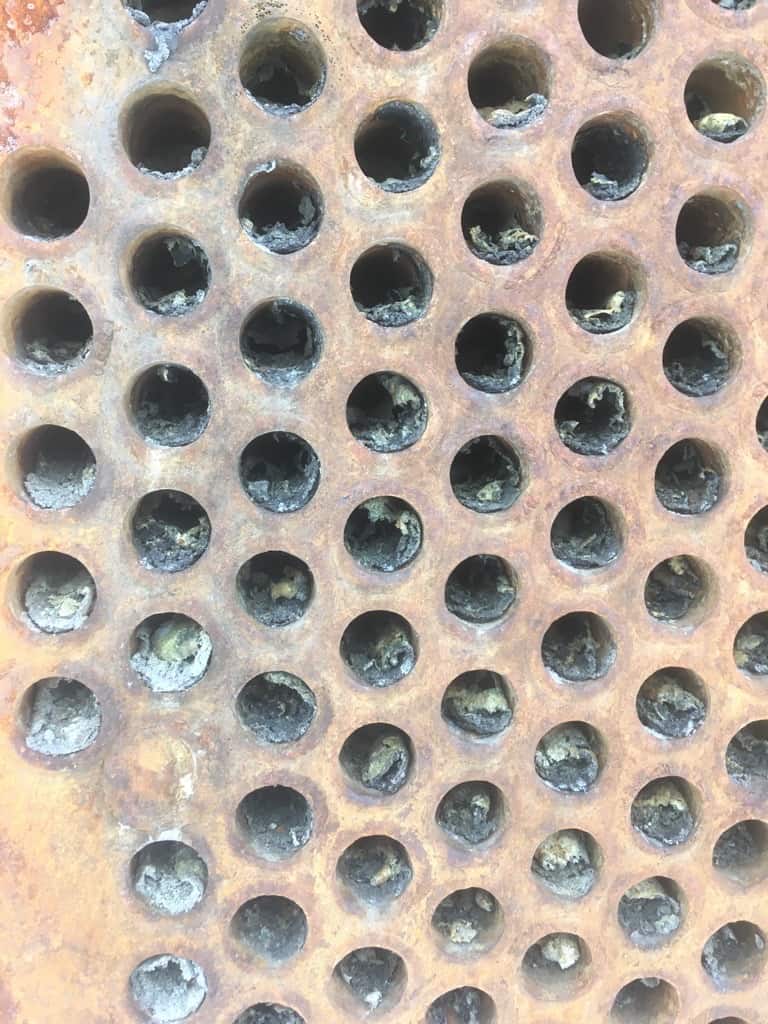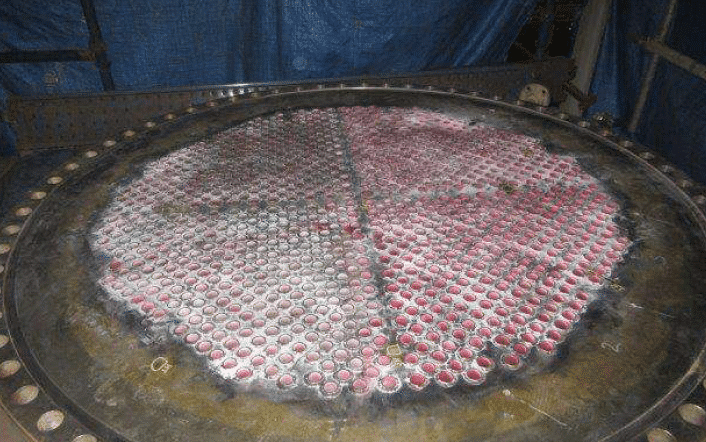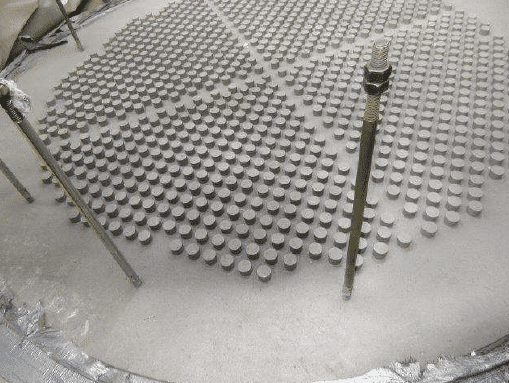We protect shell and tube heat exchanger components from corrosion, erosion, and metal wastage by upgrading the surface metal alloy in-situ, on-site, using IGS high velocity thermal spray (HVTS) cladding or coating.
The installation of IGS HVTS claddings as an erosion/corrosion mitigation strategy reduces the future maintenance costs, repair requirements, and downtime of heat exchangers operating with aggressive chemicals or flow parameters. We pair our proprietary fired heater coating technology with the unmatched site experience of IGS to execute projects to strict quality standards in tight time schedules on shutdown/turnaround critical paths. We spray metal alloy coatings in the USA, Europe, the Middle East, India, SE-Asia, and all around the world.
Wherever there is a requirement to transfer energy from one production stream to another (whether it is from a liquid, vapor, or gas), to raise or lower the process fluid temperature, a heat exchanger will be used. There are many designs of heat exchangers, and the equipment has many names in a refinery or petrochemical plant (phase change units, reboilers and condensers, waste heat recovery units, hot gas boilers, etc.). The most common types are shell and tube heat exchangers. Within the shell section, multiple tubes pass through, enabling the transfer of heat from the shell side fluids to the tube side fluids.

Dependent upon the design and operating parameters of heat recovery units and HEX, many corrosion challenges can occur. Typically, erosion/corrosion is common on the tube sheet surface. This can be due to a number of factors:
The tube sheet and tubes are made from different metals as they require different properties. This means that a bimetallic corrosion process can set up where these two metals are in contact and the right environmental conditions exist (g., anode, cathode, metallic pathway, and electrolyte). The tube alloy is typically more noble and more corrosion resistant than the alloy used for the shell or tube sheet.
In many high-temperature gas exchangers, the high velocity combined with the operating conditions leads to metal dusting corrosion on the leading edges of the tubes.
Condensation can occur when reboilers are offline or not operated in their designed temperature range, this can lead to the leaching of corrosive media from the gas flow (g., H2S or CO2 in sour gas) and aggressive corrosion on the exposed metal.
The design conditions for a process are frequently not met in terms of the operating environment or the chemical composition, meaning that the alloy of choice for the equipment is no longer fit for purpose as the environment has changed from the original FEED. This can be due to the carryover of corrosive media (g., H2S, CO2, acids from high TAN crude, amine, etc.), process control, etc. leading to corrosion of the tube sheet, header box, end covers, and shell.
Corrosive process media coupled with high-temperature operating conditions, high-velocity flow or dissimilar metals can cause corrosion or metal dusting in heat exchangers.
To prevent heat exchanger corrosion, you can apply a corrosion-resistant alloy (CRA) or a coating that would isolate the substrate from the environment.
Bimetallic or galvanic corrosion, chemical corrosion and metal dusting can lead to metal wastage in heat exchangers.
The heat exchanger tube sheet, dollar plate, channel head and end cover typically suffer from corrosion or metal dusting. The heat exchanger shell can also be affected. Fouling build-up can also result in reduced heat transfer efficiency and potential equipment failure.
IGS is here to provide information, answer questions and create an effective solution for your needs.
When these corrosive or erosive environments occur, the metal alloy of fabrication of the heat exchanger equipment is attacked, causing metal wastage and a loss of the metal wall thickness of the unit. If left unaddressed this can lead to leaks and a loss of containment.

Once the surface of the heat exchanger shell or tube sheet has started to corrode and pitting develops metal loss increases due to the turbulent flow in this area, creating an even more aggressive erosion/corrosion cycle.
It is therefore critical to mitigating corrosion through corrosion management strategies, such as a surface corrosion barrier of high-temperature corrosion-resistant alloy applied by IGS HVTS.

The operating conditions in heat exchanger units are highly varied, due to their common function and use throughout the refining process. Corrosion management strategies for the internal protection of reboilers and coolers have included the use of organic coating systems, weld overlay or build-up, and complete vessel replacement. Limitations exist with respect to the long-term durability of liquid epoxy coatings in this challenging environment. It frequently meets premature failure of the corrosion barrier, exposing the parent metal to the corrosive environment and leading to metal wastage and loss of the pressure boundary wall thickness. This often occurs prior to inspection and discovery at the next available shutdown or turnaround.
Once this type of metal wastage has occurred, mechanical repairs to the unit are necessarily leading to Heat Affected Zones (HAZ), Post Weld Heat Treatment (PWHT) requirements, and new locations at high risk of corrosion (weld seams, etc.). In addition, repairs are often costly and time-consuming due to the requirements to pull out and then replace the tube bundle when working on the heat exchanger shell.
This type of discovery scope leads to challenging repair requirements, a negative impact on shutdown schedules, the heat exchanger unit and hence the process availability. Turnaround time restrictions limit the feasibility and attractiveness of mechanical repairs or section/vessel replacement.
IGS HVTS coating technology allows the process owner to upgrade the internal metal alloy of a heat exchanger tube sheet. We create a new corrosion-resistant coating without the creation of HAZ or the requirement for PWHT.
The IGS HVTS noble coating is non-reactive and inert to the wide-ranging operating environments in heat exchanger vessels and columns. We develop specific alloys, freezing the metal condition, and preventing any further internal metal wastage in your equipment’s unique environment. This technology, combined with the unmatched site experience of IGS, provides the asset integrity manager with a turnkey, long-term solution to corrosion.

IGS standard Quality Control (QC) practices include the final inspection of the work scope and the generation of an electronic thickness record with mapped electromagnetic stand-off gauge readings on a defined reference grid across the area of the corrosion-resistant metal coating with HVTS. A customer can use this record, as well as selected benchmarked locations for later inspections to confirm, in service, that the HVTS coating has maintained its integrity, and no metal loss had occurred.
Unlike organic coating systems, HVTS metallic claddings are robust, long-term durable solutions with high mechanical toughness, abrasion, and steam out resistance and wide service temperature and pressure ranges. Their use can substantially decrease the vessel life cycle cost. It can also allow plant inspection teams to extend the required inspection intervals and vessel intervention on these critical pieces of process equipment.
The installation of IGS HVTS claddings as a corrosion mitigation strategy will reduce the future maintenance costs, repair requirements, and downtime of the heat exchanger tube sheet. Call us to ensure heat exchanger availability as required for the ongoing productivity of the plant.